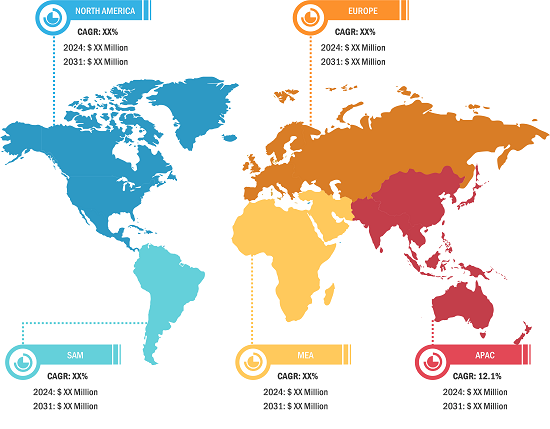Rising Need for Maritime Vessel Management to Fuel Maritime Analytics Market Growth During Forecast Period
According to our latest study, “Maritime Analytics Market Size and Forecast (2021–2031), Global and Regional Share, Trend, and Growth Opportunity Analysis – by Component, Deployment Mode, Application, End User, And Geography," the market was valued at US$ 1.27 billion in 2024 and is expected to reach US$ 2.56 billion by 2031; it is estimated to record a CAGR of 10.6% from 2025 to 2031. The report includes growth prospects owing to the current maritime analytics market trends and their foreseeable impact during the forecast period.
Factors such as the increasing complexity of global trade and the growing pressure to enhance operational efficiency, reduce costs, and ensure sustainability are driving the demand for advanced maritime vessel management solutions. As the maritime industry faces heightened competition and regulatory scrutiny, effective vessel management becomes critical for ensuring optimal performance, reducing downtime, and improving the overall lifespan of assets. Maritime analytics offer valuable insights to optimize vessel operations, streamline maintenance processes, and enhance safety. Technologies such as predictive maintenance enable the collection and analysis of vast amounts of real-time data from vessels, providing actionable insights into operational parameters, including fuel consumption, engine performance, weather patterns, and cargo handling. With predictive analytics, vessel operators can anticipate maintenance needs, mitigate risks, and make informed decisions that drive operational efficiency.
Maritime Analytics Market Analysis — by Geography
Maritime Analytics Market Size and Forecast (2021 - 2031), Global and Regional Share, Trend, and Growth Opportunity Analysis Report Coverage: By Component (Software and Services), Deployment (Cloud and On-Premises), Application (Predictive and Prescriptive Analytics, Optimal Route Mapping, Pricing Insights, Vessel Safety and Security, and Others), End User (Commercial and Military), and Geography
Maritime Analytics Market Size, Key Players and Regional Analyses
Download Free Sample
Source: The Insight Partners Analysis
In January 2025, BASS Software launched BASSnet Web 3.0, the cutting-edge web solution designed to transform ship management operations. By transitioning to a scalable web service and cloud-based web architecture, BASSnet Web paves the way for operational efficiency and modernization. The launch of BASSnet Web 3.0 underscores BASS's evolution into a pure SaaS company. This modern web solution is the culmination of cutting-edge technology and a fully browser-based approach that integrates advanced analytics, AI capabilities, and robust cybersecurity measures.
ABB; ZeroNorth A/S; Solitwork; Windward Ltd; Kpler; OrbitMI, Inc; Shipnet; Hexagon AB; Inmarsat GHL; and Maritech are among the key players profiled in the maritime analytics market report. Other major players were also analyzed during the market study to get a holistic view of the market and its ecosystem.
The report includes the maritime analytics market forecast by component, deployment mode, application, end user, and geography. Based on component, the market is bifurcated into software and services. In terms of revenue, the software segment held the largest maritime analytics market share and is expected to record the highest CAGR during the forecast period.
The scope of the maritime analytics market report focuses on North America (the US, Canada, and Mexico), Europe (Spain, the UK, Germany, France, Italy, and the Rest of Europe), Asia Pacific (South Korea, China, India, Japan, Australia, and the Rest of Asia Pacific), the Middle East & Africa (South Africa, Saudi Arabia, the UAE, and the Rest of Middle East & Africa), and South & Central America (Brazil, Argentina, and the Rest of South & Central America). Asia Pacific dominated the market in 2023, followed by Europe and North America.
The Europe maritime analytics market is segmented into Germany, France, the UK, Italy, Russia, and the Rest of Europe. In terms of revenue, the UK held the largest maritime analytics market share in Europe. The maritime analytics market in the UK is experiencing strong growth, driven by strategic factors that align with the country's position as a global maritime hub. The UK's extensive coastline, coupled with renowned ports such as London Gateway, Liverpool, and Southampton, positions it as a key player in international trade and logistics. As a result, there is a soaring demand for advanced maritime analytics to optimize port operations, improve cargo handling, and enhance fleet management. Further, the region is undergoing digital transformation in the maritime industry. In June 2024, The Port of Aberdeen, Scotland's largest berthage port, announced its plan to become the UK's leading smart port with a US$ 1.2 million (£1 million) investment in advanced technology aimed at enhancing safety, connectivity, and sustainability. This initiative follows the Port's US$ 542 million (£420 million) investment in the transformative Aberdeen South Harbour expansion project, the largest marine infrastructure development in Trust Port history, which officially opened in September 2023.
Contact Us
Phone: +1-646-491-9876
Email Id: sales@theinsightpartners.com